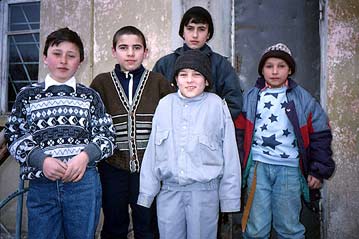UNHCR and IOM seek funds for CIS programmes
UNHCR and IOM seek funds for CIS programmes
UNHCR and IOM launched a $7.6 million joint appeal Friday for a pilot programme linked to the massive involuntary migratory movements taking place in the Commonwealth of Independent States (CIS). The programme includes a series of projects designed to plug some of the yawning gaps in the management of displacement and migration in the Russian Federation, Ukraine and Belarus.
The projects are primarily aimed at helping local authorities and non-governmental agencies (NGOs) integrate vulnerable and often destitute refugees, internally displaced, formerly deported peoples and people forced to return to their ancestral homelands by conflicts in other CIS countries. At present, many of these people are living extremely precariously in a social and legal vacuum with nowhere to go and no one to turn to.
Since the late 1980s, at least 9 million people have moved to, within or between CIS countries as a result of conflicts, environmental disasters or a range of fears and complications arising from the sudden and unprecedented disintegration of a single state - the former Soviet Union - into 15 separate ones.
Many of the displaced and other types of migrant are struggling to carve out a new life in societies which are themselves struggling to cope with the social, economic and political upheaval that has followed the break-up of the Soviet Union.
The CIS countries lack the necessary systems, personnel and experience for coping with types of movement which did not exist a decade ago, and are overwhelmed by the staggering numbers involved.
The UNHCR/IOM projects are designed to strengthen the embryonic systems and structures which have already been set up, as well as to establish new ones. They include the remodelling, refurbishing and re-equipping of reception centres in the Russian Federation and Ukraine, as well as the establishment of a new reception centre in Belarus; the upgrading of medical facilities; establishment of reliable information systems, including equipment and training; on-the-job training for local NGOs implementing the projects, as well as for local government officials in charge of migration, and immigration officials at points of entry.
Legal assistance will be provided for some of the groups most in need, including some of the 260,000 Crimean Tatars who have so far returned to their ancestral homeland half a century after they were deported to Central Asia by Stalin. A recent assessment mission to Crimea has identified some 60,000 Crimean Tatars who are either stateless or in a nebulous position with regard to citizenship.
Wherever possible, support will be given to the emerging, but still fragile, under-equipped and under-funded local NGOs, since their strength and effectiveness will be a key factor in the future management of migration and displacement.
Friday's appeal, covering a six-month period up to the end of 1996, is a first step by the two agencies to follow up on the guiding principles and Programme of Action endorsed by a conference held in Geneva at the end of May.
The CIS Conference on Refugees and Migrants, organized by UNHCR, IOM and the human rights arm of the Organization for Security and Co-operation in Europe (OSCE), stressed that the astonishing scale and complexity of the movements could be dangerously destabilizing. The 87 participating states endorsed an ambitious regional plan that provides a framework for dealing more effectively with existing problems as well as preventing or mitigating further uncontrolled and unnecessary mass movements.
A further joint appeal covering all the CIS countries will be launched later in the year. However, senior UNHCR and IOM officials stressed that the work needs to start straight away if the momentum created by the CIS Conference is to be maintained. In addition, experience gained through the implementation of the pilot projects will help guide future programmes throughout the region.
The two agencies also drew attention to a critical $29.2 million shortfall in funding for ongoing programmes which pre-dated the CIS Conference. Operations for refugees and displaced people in the Caucasus and Central Asia are seriously under-funded.
Since 1989, seven major conflicts have between them forced over 3.6 million people to leave their homes. In addition to those displaced by conflicts, the strains brought on by the sudden disintegration of the Soviet Union have triggered or encouraged other huge movements, some of them unique to the CIS countries. Some 3.3 million people, including 600,000 from conflict zones, have felt compelled to leave their homes and return to their country of ethnic origin. The CIS Conference process also identified return or emigration movements of 1.2 million people who had been deported en masse during the 1940s, as well as 700,000 people who have fled ecological disasters, 600,000 illegal migrants and 70,000 asylum-seekers.


